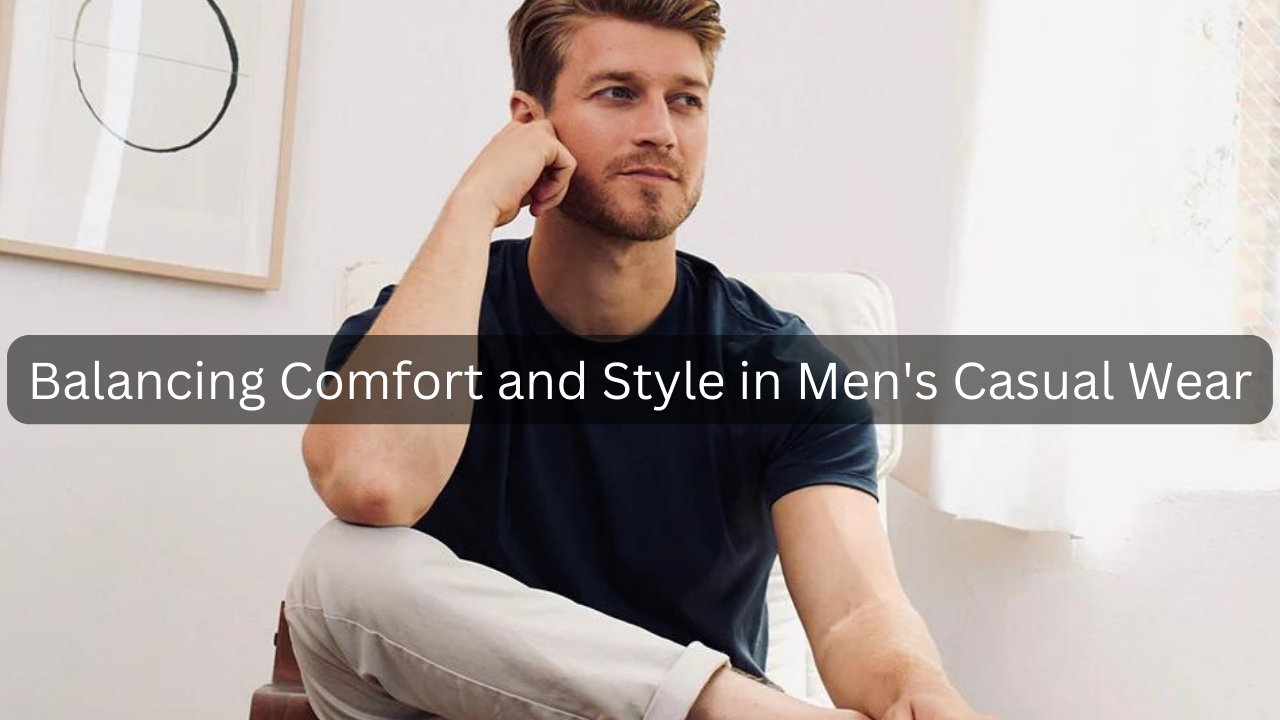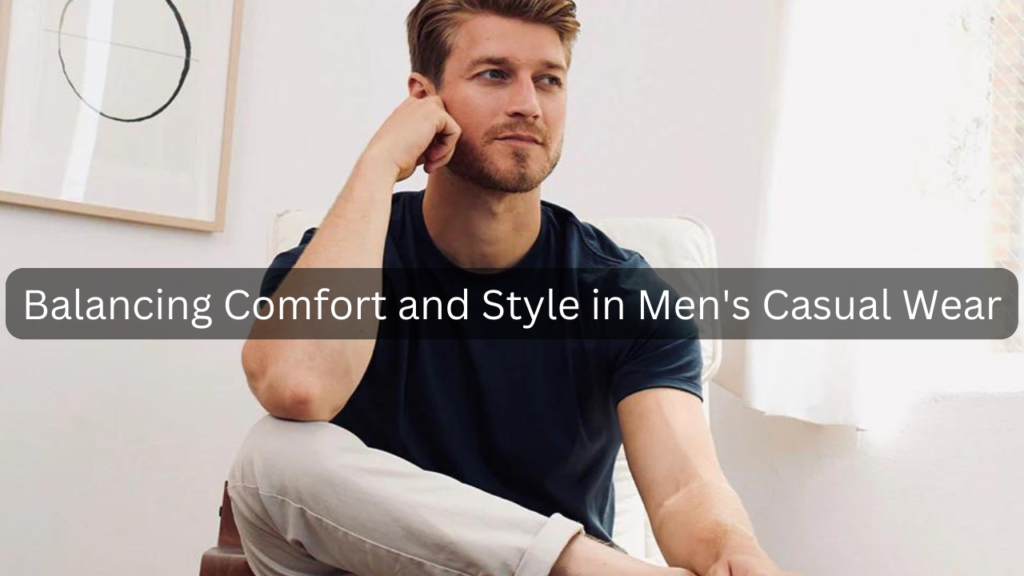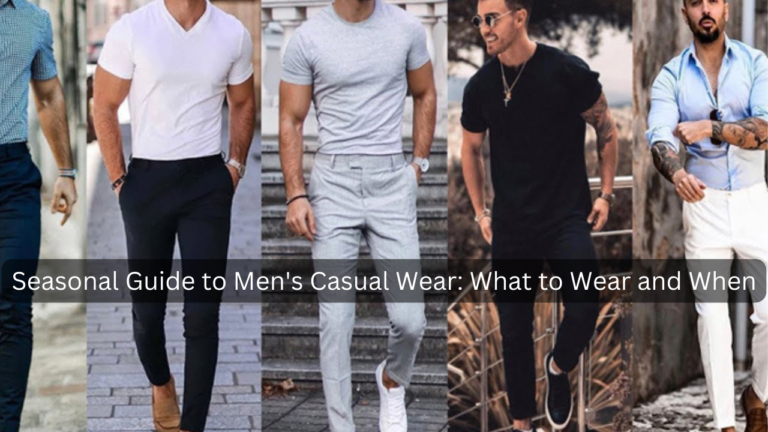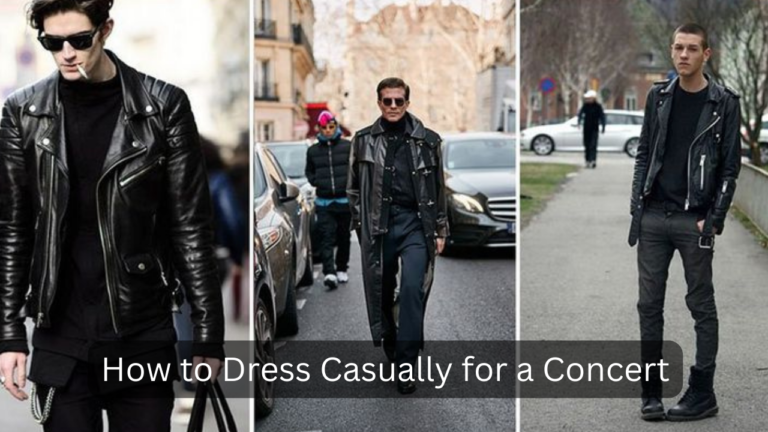

Table of Contents
Introduction
In the realm of men’s fashion, the concept of casual wear has transcended mere comfort to encompass a harmonious blend of comfort and style. No longer confined to lazy weekends or off-duty hours, casual wear today plays a pivotal role in defining personal style and making a statement about one’s lifestyle. The art lies not only in feeling relaxed but also in looking effortlessly stylish while doing so. This article delves into the crucial balance between Comfort and Style in Men’s Casual Wear, offering insights into how to achieve a look that is both comfortable and aesthetically pleasing.
Importance of Balancing Comfort and Style in Casual Wear
The significance of striking a balance between comfort and style cannot be overstated. Comfort forms the foundation upon which style flourishes; when one feels at ease in their clothing, confidence naturally follows. Conversely, style adds flair and personality to comfort, elevating everyday outfits attire from mundane to memorable. This symbiotic relationship empowers individuals to express themselves authentically through their clothing choices while ensuring practicality and ease of movement in any setting.
Overview of Key Elements to Consider
When crafting a balanced casual ensemble, several key elements come into play:
Fabric Selection: Opting for breathable, natural fabrics such as cotton, linen, and lightweight blends ensures comfort throughout the day, especially in warmer climates or during active pursuits.
Fit and Silhouette: Choosing relaxed yet well-tailored pieces allows for unrestricted movement without compromising on style. Whether it’s a well-fitted pair of jeans or a softly structured blazer, the fit is paramount in achieving a polished look.
Color and Pattern Coordination: Harmonizing colors and integrating subtle patterns can enhance visual interest without overwhelming the outfit. Neutral tones paired with complementary hues create a cohesive appearance suitable for various every occasions.
Footwear and Accessories: From versatile sneakers to classic loafers, selecting footwear that combines comfort with style anchors the outfit. Similarly, accessorizing with minimalistic watches, belts, or sunglasses adds a personal touch while maintaining practicality.
Understanding Comfort in Casual Wear
Comfort in casual wear goes beyond physical ease; it encompasses a holistic sense of well-being and confidence derived from how clothing feels and functions in various environments. Understanding the nuances of comfort allows individuals to curate wardrobes that support their lifestyles without compromising on personal style.
Definition of Comfort in Clothing
Comfort in clothing can be defined as the state of physical ease and psychological reassurance that a garment provides. It involves how well the clothing fits, the tactile qualities of the fabric against the skin, and the freedom of movement it allows. Ultimately, comfort translates into a sense of relaxation and confidence, enabling individuals to move through their day with ease.
Factors Influencing Comfort
Several key factors influence the comfort of casual wear:
Fabric Choice: Natural fibers like cotton, linen, and modal are breathable and absorbent, making them ideal for regulating body temperature. Synthetic blends like polyester can offer stretch and durability. The choice of fabric impacts how comfortable and suitable the clothing feels in different weather conditions.
Fit: The fit of clothing plays a crucial role in comfort. While preferences may vary, a balanced fit that allows freedom of movement without excess fabric or tightness ensures comfort. Tailoring can refine fit to individual body shapes, enhancing both comfort and style.
Construction and Design: Seams, stitching, and construction techniques contribute to garment comfort. Flat seams, soft linings, and ergonomic design elements prevent chafing and irritation, especially in activewear or garments worn for extended periods.
Functionality: Garments designed with practical features such as pockets, adjustable closures, and moisture-wicking properties enhance comfort by addressing specific needs and activities.
Practical Tips for Maximizing Comfort
Achieving maximum comfort in casual wear involves thoughtful consideration and experimentation:
Choose Breathable Fabrics: Opt for natural fibers or moisture-wicking synthetics to stay comfortable in different climates.
Prioritize Fit: Invest in well-fitted clothing that allows ease of movement without constriction.
Layer Wisely: Layering lightweight pieces allows flexibility to adjust to temperature changes throughout the day.
Consider Seasonal Needs: Adapt clothing choices to seasonal demands, incorporating lightweight fabrics for summer and insulating layers for winter.
Personalize with Preferences: Customize clothing choices based on personal preferences for texture, stretch, and style tips to enhance comfort.
Defining Style in Casual Wear
Style in casual wear embodies the art of combining clothing and accessories to create a cohesive and personalized aesthetic. It transcends trends to reflect individual preferences, attitudes, and lifestyle choices, making a statement about who you are and how you wish to be perceived.
What Constitutes Style in Casual Outfits?
Style in casual outfits for men can be defined by several elements:
Color and Pattern Coordination: Harmonizing colors and integrating patterns skillfully can create visual interest without overwhelming the outfit. Whether it’s pairing neutrals for a minimalist look or mixing patterns for a bold statement, color coordination plays a crucial role in defining style.
Fit and Proportion: A well-fitted silhouette enhances the overall appearance of casual wear. Balancing proportions and choosing cuts that flatter your body shape contribute to a polished and stylish ideas look.
Details and Accessories: The thoughtful addition of accessories such as watches, belts, scarves, and eyewear can elevate a casual outfit. These details not only add functionality but also reflect personal taste and style.
Different Style Preferences
Casual wear encompasses a spectrum of style preferences, each reflecting unique tastes and influences:
Classic Style: Characterized by timeless pieces and understated elegance, classic casual wear emphasizes quality fabrics, clean lines, and enduring silhouettes. It exudes sophistication and versatility.
Contemporary Style: Embracing current fashion trends while maintaining a modern edge, contemporary casual wear often features bold colors, innovative designs, and eclectic combinations. It reflects a dynamic and progressive approach to personal style.
Casual-Chic: Striking a balance between casual comfort and refined sophistication, casual-chic style blends relaxed staples with polished accents. It embodies effortless elegance and an understated yet impactful aesthetic.
How Style Enhances Personal Expression
Style in casual wear serves as a powerful means of personal expression:
Reflecting Personality: Clothing choices communicate individual values, interests, and personality traits. Whether it’s through color preferences, accessory choices, or garment styles, personal style allows for self-expression and authenticity.
Cultural and Lifestyle Influences: Style in casual wear can be influenced by cultural heritage, regional trends, and lifestyle considerations. It adapts to reflect diverse backgrounds and resonates with personal experiences and aspirations.
Boosting Confidence: When aligned with personal preferences and comfort, style enhances confidence and self-assurance. Feeling good in what you wear empowers individuals to navigate social and professional environments with ease.
Key Elements for Balancing Comfort and Style
Achieving a harmonious balance between Comfort and Style in Men‘s Casual Wear involves thoughtful consideration of several key elements:
Choosing the Right Fabrics for Comfort and Style
Fabric selection plays a pivotal role in determining the Comfort and Style in Men’s Casual fashion Wear of casual clothing:
Natural Fibers: Opt for breathable fabrics such as cotton, linen, and modal, which offer comfort by allowing air circulation and absorbing moisture. These materials are ideal for maintaining comfort in various weather conditions.
Synthetic Blends: Consider fabrics like polyester blends or technical fabrics that offer stretch, durability, and moisture-wicking properties. These materials provide comfort while enhancing performance and ease of movement.
Quality and Texture: Choose fabrics with a soft hand-feel and smooth texture that feel pleasant against the skin. The tactile qualities of fabrics contribute significantly to overall comfort and enhance the perceived quality of casual attire.
Importance of Proper Fit in Casual Clothing
A well-fitted garment enhances both Comfort and Style in Men’s Casual Wear:
Tailoring: Invest in tailoring or alterations to achieve a customized fit that flatters your body shape. Properly fitted clothing allows for unrestricted movement and enhances comfort by preventing fabric bunching or sagging.
Proportion and Silhouette: Pay attention to the silhouette of casual clothing items. Balance loose-fitting pieces with structured or tailored elements to create a cohesive look that maintains comfort without compromising on style.
Adjustability: Look good for garments with adjustable features such as drawstrings, elastic waistbands, or adjustable cuffs. These elements allow for flexibility in fit and ensure comfort throughout the day.
Incorporating Versatility into Your Wardrobe
Versatility is key to balancing Comfort and Style in Men’s Casual Wear:
Mix and Match Basics: Build a foundation of versatile basics such as neutral-colored tops, denim jeans, and lightweight jackets that can be easily paired and layered to create different outfits.
Layering: Embrace layering techniques to adapt to changing weather conditions and styling preferences. Layering lightweight fabrics and versatile outerwear pieces adds depth to your wardrobe while offering practical comfort.
Multi-Functional Pieces: Invest in multi-functional clothing items such as reversible garments, convertible styles, or versatile accessories that can be styled in multiple ways. These pieces maximize wardrobe versatility and cater to various casual occasions.
Practical Tips for Achieving Balance
Achieving a harmonious balance between Comfort and Style in Men’s Casual Wear involves mastering practical techniques that enhance both aspects seamlessly.
Layering Techniques for Style and Comfort
Layering is a versatile approach to elevate your casual outfits while ensuring comfort:
Base Layer: Start with a lightweight, breathable base such as a fitted T-shirt or a comfortable undershirt that absorbs moisture and provides a foundation for layering.
Middle Layer: Add warmth and style with a button-up shirt, lightweight sweater, or casual blazer. Opt for fabrics like cotton or merino wool that offer insulation without bulk.
Outer Layer: Complete the look with a versatile jacket or coat that suits the weather conditions. Choose outerwear with functional features such as water resistance, adjustable hoods, or insulated linings for added comfort.
Mix Textures and Patterns: Experiment with textures and subtle patterns to add visual interest while maintaining a cohesive look. Layering different textures like knits, denim, and lightweight fabrics creates depth and dimension.
Selecting Footwear that Complements Both Comfort and Style
Footwear is essential for balancing comfort and style in casual outfits:
Sneakers: Choose sneakers with cushioned insoles and supportive outsoles for all-day comfort. Opt for versatile styles in neutral colors or subtle patterns that complement casual attire.
Loafers or Boat Shoes: These styles offer a blend of comfort and sophistication. Look for loafers with padded footbeds and boat shoes with non-slip soles for added comfort and functionality.
Boots: Select boots crafted from durable materials like leather or suede, with supportive arches and cushioned insoles. Boots provide warmth and protection while adding a rugged or polished touch to casual ensembles.
Accessorizing Effectively Without Compromising Comfort
Accessories can enhance your casual outfit without sacrificing comfort:
Belts: Choose lightweight and flexible belts made from leather or canvas with adjustable closures for comfort. Coordinate belt colors with footwear or other accessories for a cohesive look.
Watches: Opt for lightweight watches with comfortable straps like leather or silicone. Consider features such as water resistance and easy-to-read dials for practicality and style.
Scarves and Hats: Add warmth and style with lightweight scarves or hats made from breathable materials like cotton or wool. Select neutral colors or subtle patterns that complement your outfit.
Bags: Carry essentials in functional yet look stylish bags such as crossbody bags or backpacks with padded straps and compartments for organization. Choose durable materials that withstand daily wear.
Seasonal Considerations in Casual Wear
Adapting your casual wardrobe to different seasons involves thoughtful consideration of both fabric choices and practical comfort:
Adapting Casual Wear for Different Seasons
Summer:
Fabric Choices: Opt for lightweight and breathable fabrics such as cotton, linen, and lightweight blends. These materials help regulate body temperature and wick moisture away from the skin, keeping you cool and comfortable in hot weather.
Clothing Styles: Choose relaxed fits and airy silhouettes that allow for airflow and ventilation. Consider shorts, lightweight T-shirts, polo shirts, and short-sleeve button-up shirts for a casual summer look.
Color Palette: Embrace lighter colors and pastel tones that reflect sunlight and help keep you cool. Avoid dark colors that absorb heat and can feel stifling in hot weather.
Winter:
Fabric Choices: Opt for insulating fabrics such as wool, cashmere, and fleece that provide warmth without adding bulk. Look for materials with moisture-wicking properties to keep you dry and comfortable in cold, damp conditions.
Layering: Layering is key to adapting casual wear for winter. Start with a thermal or moisture-wicking base layer, add a mid-layer for insulation (e.g., sweaters, fleece jackets), and finish with a weather-resistant outer layer (e.g., parkas, wool coats) to protect against wind and precipitation.
Footwear: Choose insulated boots with traction soles to keep your feet warm and dry. Look for waterproof or water-resistant options to withstand snow and slush while maintaining comfort.
Seasonal Fabric Choices and Their Impact on Comfort
Spring and Fall:
Transition Fabrics: During transitional seasons like spring and fall, opt for versatile fabrics such as cotton twill, denim, and lightweight wool blends. These materials provide comfort and flexibility as temperatures fluctuate.
Layering Essentials: Layering lightweight fabrics allows you to adjust to changing temperatures throughout the day. Mix textures and weights to create visual interest while maintaining comfort.
Impact on Comfort:
Breathability: In warmer seasons, breathable fabrics like cotton and linen enhance comfort by allowing air circulation and moisture absorption. This prevents overheating and promotes a cool, dry feeling.
Insulation: Cold-weather fabrics such as wool and fleece provide insulation by trapping body heat and blocking cold air. These materials keep you warm and comfortable in chilly conditions without compromising mobility.
Moisture Management: Fabrics with moisture-wicking properties help regulate body temperature by pulling sweat away from the skin. This prevents dampness and discomfort, especially during physical activities or in humid climates.
Sustainable and Ethical Considerations in Casual Wear
Incorporating sustainable and ethical practices into casual wear choices is crucial for promoting environmental responsibility and ethical standards within the fashion industry:
Importance of Sustainable Fashion Choices in Casual Wear
Environmental Impact: Opting for sustainably produced fabrics such as organic cotton, hemp, or recycled materials reduces the carbon footprint and minimizes water usage and chemical inputs associated with conventional fabric production.
Longevity and Durability: Investing in quality garments that are designed to last encourages a more sustainable approach to consumption. Choosing timeless styles and versatile pieces promotes a wardrobe that transcends seasonal trends.
Ethical Labor Practices: Supporting brands that uphold fair labor standards ensures that garment workers receive fair wages, safe working conditions, and respect for their rights. Ethical brands prioritize transparency and accountability throughout their supply chains.
Ethical Considerations in Clothing Production and Consumption
Supply Chain Transparency: Transparency in sourcing and manufacturing processes allows consumers to make informed choices about the products they purchase. Look for brands that disclose information about their suppliers and production practices.
Animal Welfare: Opt for cruelty-free alternatives to materials derived from animals, such as vegan leather or plant-based fibers. Consider certifications like PETA-approved vegan or cruelty-free labels when selecting clothing and accessories.
Circular Economy: Embrace practices that extend the lifecycle of clothing through recycling, upcycling, or donating garments to reduce waste. Choose brands that offer take-back programs or promote second-hand markets for pre-loved clothing.
Case Studies and Inspirations
Examples of Celebrities or Fashion Icons Known for Balancing Comfort and Style
David Beckham: Renowned for his effortless blend of casual and tailored pieces, Beckham often incorporates classic staples like denim jackets, tailored trousers, and crisp shirts with sneakers or boots.
Ryan Reynolds: Known for his laid-back yet polished style, Reynolds frequently pairs casual essentials like T-shirts or hoodies with tailored blazers and dark denim, showcasing a balance of comfort and sophistication.
Case Studies of Successful Casual Wear Outfits
Off-Duty Chic: A successful perfect casual outfit might feature a well-fitted crew neck T-shirt paired with slim-fit jeans and casual sneakers. Adding a lightweight bomber jacket or a baseball cap can enhance the look while maintaining comfort.
Smart Casual: For a more polished casual ensemble, consider combining chinos with a button-up shirt and loafers or desert boots. Layering with a casual blazer or cardigan completes the look, suitable for a variety of social settings.
These considerations and examples illustrate how sustainable practices and ethical considerations can be integrated into casual wear choices, alongside inspiring case studies of celebrities and successful outfit compositions.
Conclusion
Balancing Comfort and Style in Men’s Casual Wear is a delicate art that empowers individuals to express their personality while feeling confident and at ease in their clothing choices. Throughout this exploration, we’ve highlighted essential strategies and considerations for achieving this balance effectively.
Recap of Balancing Comfort and Style
Understanding Comfort: From choosing breathable fabrics to ensuring proper fit, prioritizing comfort forms the foundation of stylish casual wear. Fabrics like cotton and linen keep you cool in summer, while wool and fleece provide warmth in winter.
Embracing Style: Style in casual wear embraces versatility, allowing for creative expression through color coordination, layering techniques, and thoughtful accessorizing. Whether your preference leans towards classic elegance or contemporary flair, finding the perfect style involves blending timeless pieces with modern accents.
Seasonal Adaptability: Adapting to seasonal changes involves selecting appropriate fabrics and layering strategically to maintain comfort without compromising on style. From lightweight options for summer to insulating layers for winter, each season offers opportunities to showcase your style sensibility.
Final Thoughts on Creating a Signature Casual Style
Crafting a signature casual style is about more than following trends—it’s about embracing individuality and expressing yourself authentically through clothing:
Experimentation: Don’t be afraid to mix and match different elements of wear casual wear to discover what resonates with your personality and lifestyle. Explore different textures, colors, and silhouettes to find combinations that make you feel comfortable and confident.
Personalization: Incorporate pieces that reflect your interests, values, and cultural influences. Whether it’s a favorite accessory, a statement jacket, or a pair of shoes that tell a story, personalizing your casual wardrobe adds depth and authenticity to your style.
Confidence: Ultimately, the key to creating a signature casual style lies in wearing your clothes with confidence. When you feel comfortable and aligned with your personal style, it radiates through your demeanor and leaves a lasting impression.
As you navigate the world of casual wear, remember that the journey to finding your signature style is ongoing and should be enjoyable. Embrace the versatility and creative freedom that casual clothing affords, and let your wardrobe reflect the best version of yourself.





